Beginning today, Wizards of the Coast is embarking on a new experiment: artist collections sold directly to the public in the form of Secret Lairs. They’re starting with a safe pick: Seb McKinnon, whose popularity is proportional to his talent, and who has been given the freedom to illustrate a disparate collection of cards. Instead of a thematic connection, McKinnon has build a narrative one, with his four cards chronicling the life, death, and rebirth of a knight errant.
While all the art in the Lair is gorgeous, the art for Damnation is truly inspired, as befits a tournament-caliber card that has been a part of Magic’s history (and periodic “when are they going to reprint this!?” discussion) since its first printing back in Planar Chaos.
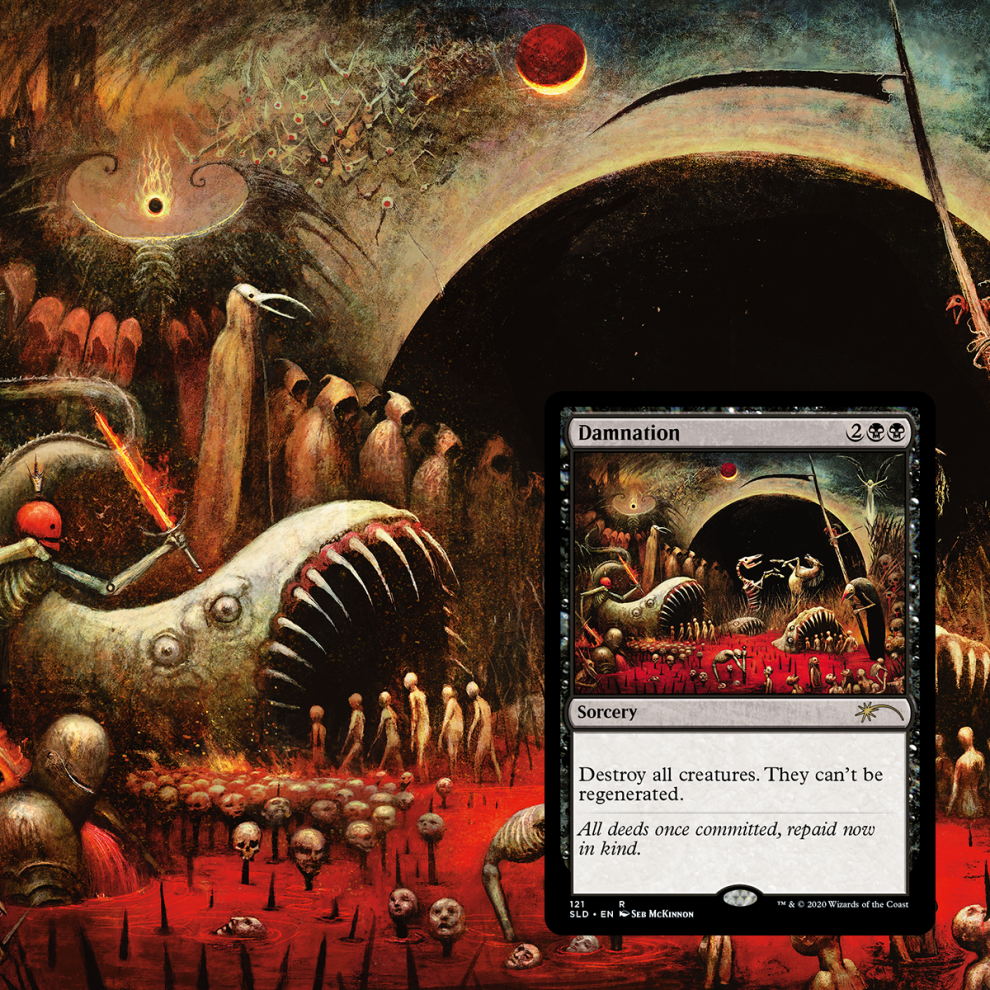
The elevator pitch for Planar Chaos was “what if Magic’s colors had developed differently?” The set included 45 “color-shifted” reprints of classics cards, nine for each color. For example: red got Prodigal Pyromancer and Pyrohemia, green got Essence Warden and Harmonize, white got Mana Tithe and Mesa Enchantress, blue got Serendib Sorcerer and Frozen Aether, and Black got Melancholy and Damnation.
In the original Alpha set of Magic, white was the color of egalitarian destruction: Armageddon, Balance, Wrath of God. This became a central part of the color’s identity; the slow subtraction of powerful mass removal from white is part of why white has become the underdog color. Shatter the Sky just isn’t the same, good as it is.
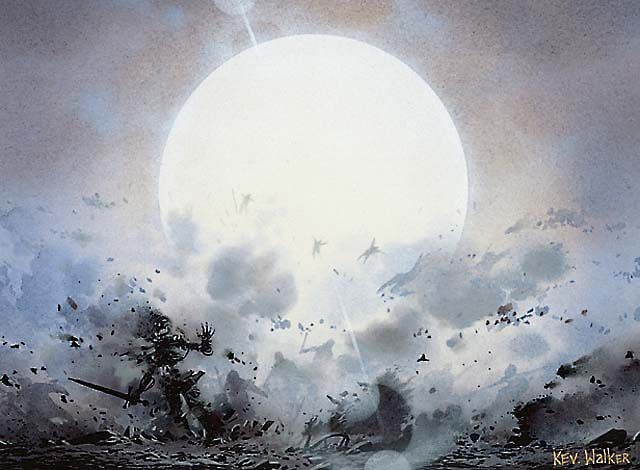
Wrath of God by Kev Walker
Damnation was an experiment, a hypothetical switch in mechanical identity to match thematic identity, but it was the exact piece Black was missing back in 2007. It bolstered Faeries into a real menace, validated Dimir Control piles like Mystical Teachings, and remained relevant after Modern became a format. I think it would be fine in Historic or perhaps even Pioneer, although its reprinting in a Secret Lair makes that unlikely in the near future. The card is iconic, much as Wrath was before it, and it was iconic because of its art. While Wrath of God showed a crowded battlefield devastated by the force of a divine explosion, Damnation
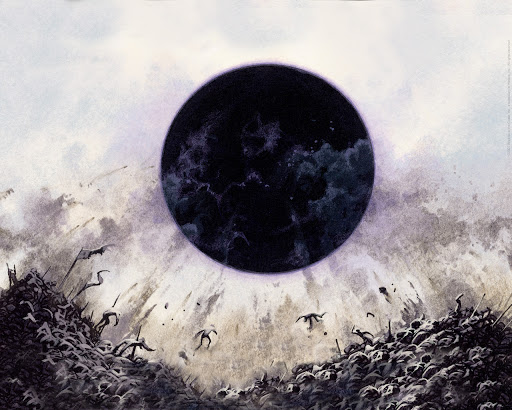
Damnation by Kev Walker.
Kev Walker’s Planar Chaos art for Damnation was a mirror of his 7th Edition Wrath of God—the art that still shows up each time the card is reprinted. While Wrath of God showed a crowded battlefield devastated by the force of a divine explosion; Damnation is a black hole, devouring both armies equally and implacably. It’s reminiscent of the destruction of Tokyo in Akira, and how the illustrator, Katsuhiro Otomo, shaded the explosion with mania-inducing crosshatching to honor the dead.
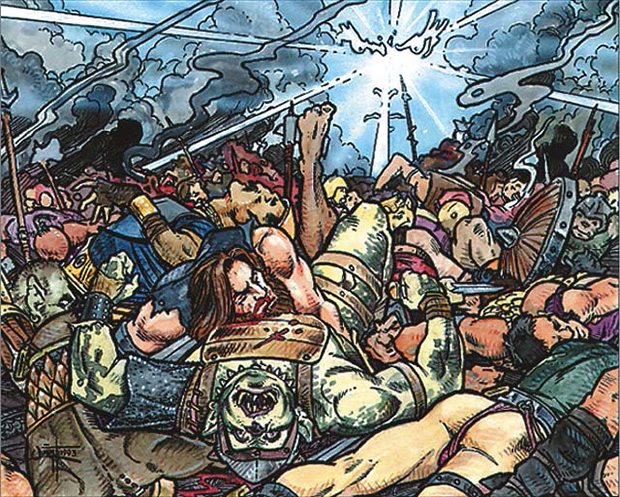
Wrath of God by Quinton Hoover
The quirky Quinton Hoover original, with the glowering face of the deity themself and the watercolor-saturated pile of corpses almost serving as a wimmelbilderbuch, set Magic’s style for a decade—but it didn’t have the majesty and sinister glory of the Damnation/Wrath of God diptych. Comparing the two side-by-side demonstrates how closely they match, and how much effort went into distinguishing them.
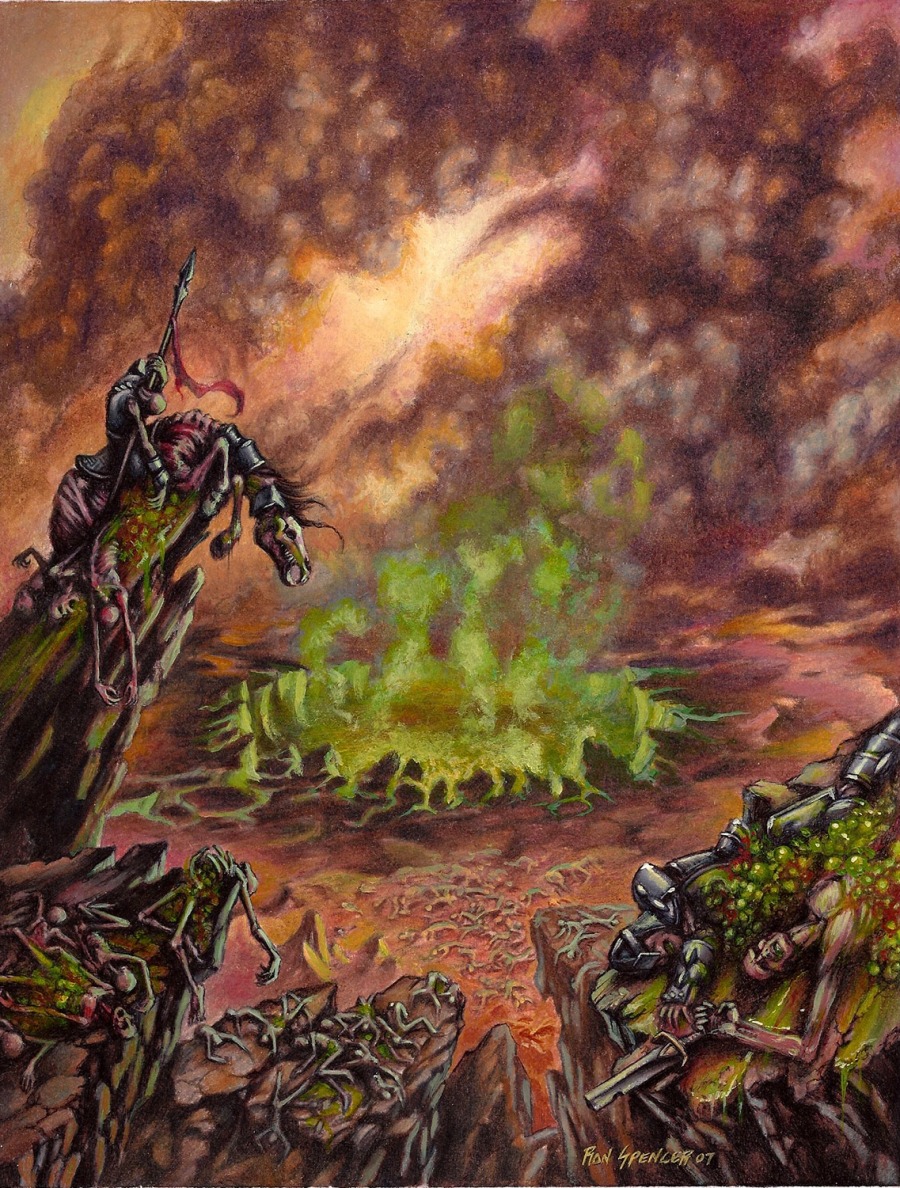
Damnation by Ron Spencer
That mirror later came up in the Player Rewards series, when Ron Spencer revisited his Player Rewards Wrath of God art in a Player Rewards Damnation. This, to me, is more personally resonant than the Kev Walker Damnation. While I appreciate Walker’s stark Damnation—the slate-clearing of an implacable and merciless god—Spencer’s Damnation is grungy and noxious. The glowing green of the crater really pops in the foil treatment; and the art itself is nicely textured, with the crater drawing focus but balanced out by the detailed foreground. It’s odd to call it “lovely,” but I wouldn’t hesitate to do so.
Indeed, I prefer it to Walker’s art, mostly because I like the concept of a god’s wrath leaving behind an impact crater. With pure omnipotence, you’d think that a god could erase humanity from Dominaria completely, through temporal manipulation or cosmic shenanigans. But gods are limited by humanity’s imagination, and so Wraths are typically depicted as superpowered nuclear bombs. Spencer depicts his Damnation as environmental as well as human. It’s not just the destruction of the warring armies, but of the battlefield, that symbolizes Damnation.
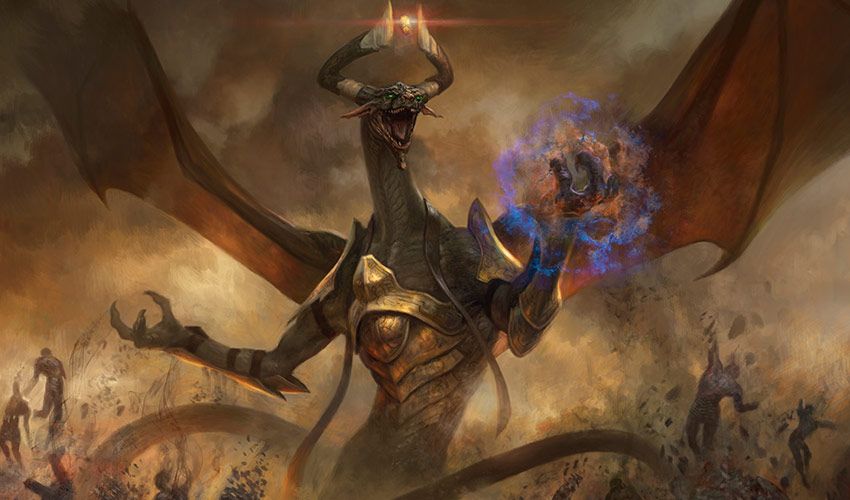
Damnation by Zack Stella
The third, and most dismissible, version of Damnation is Zack Stella’s Amonkhet Masterpiece Damnation. I’m generally a fan of Stella’s work, but this piece is done no favors by the muddy printing of the Amonkhet Masterpieces. Instead of a black hole or a neutron bomb, we have a 100-foot dragon striking a pose. Wizards meant to turn this moment into an iconic moment in Magic’s current story, with Nicol Bolas returning to his army incubator plane of Amonkhet; but it’s promotional art, not a masterpiece.
I have no qualms, however, about calling Seb McKinnon’s new Damnation a masterpiece.
Seb McKinnon first started illustrating for Magic with Return to Ravnica block—his Immortal Servitude and Debt to the Deathless showed off his macabre brilliance and meticulous technique. But it was Topplegeist that cemented him as an artist to watch to me—the warped proportions of the little specter, the caught-in-the-action framing of the piece, the alien whimsy of it spoke to what I want to see in Magic art. McKinnon paints Magic spirits beautifully—Shadows Over Innistrad gave us Pale Rider of Trostad, Topplegeist, Selfless Spirit, Fogwalker, Erdwal Illuminator, and Chilling Grasp each display a different example in the taxonomy of phantoms. In terms of style, he reminds me most of Adam Rex, whose dreamy color palettes and twisted figures are similar to McKinnon’s (Urborg Uprising, Wicked Pact, 10th Edition Terror); but McKinnon has a clarity and compositional confidence that are next level.
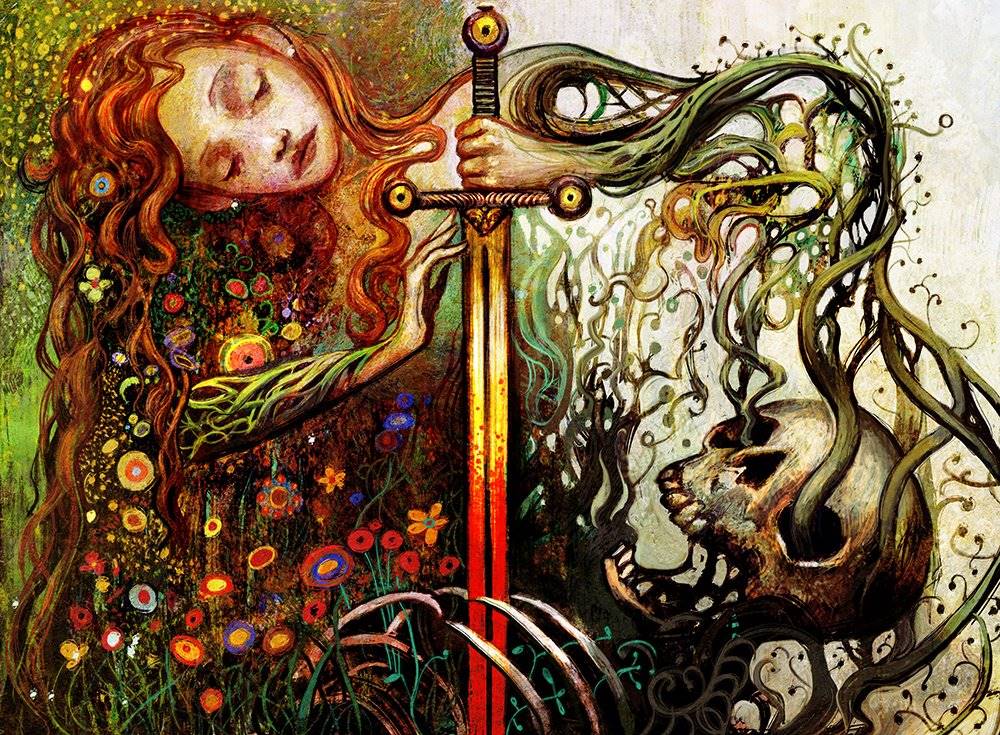
Vengeful Rebirth by Seb McKinnon
It’s hard to be both versatile and immediately recognizable, especially in a 2-inch art box, but McKinnon manages it. His illustrated manuscript style (Vengeful Rebirth, Deliver Unto Evil, Phantom Tiger) is immediately recognizable; but he also gets tagged in for simple tableaux (Mind Rot, Agonizing Syphon); still lifes (Chalice of the Void, Millennial Gargoyle); low-pick Limited cards (Unholy Indenture); and landscapes (Silent Clearing, Misty Rainforest).
One of my favorite pieces of his is almost a Walker Damnation in and of itself. When Soulherder’s art dropped, prior to the reveal of the card, players speculated that it would be some mass removal spell or world-destroying legend, instead of a Limited linchpin. Luckily, we’ve now circled back around to give McKinnon another shot at an apocalypse with his Secret Lair.
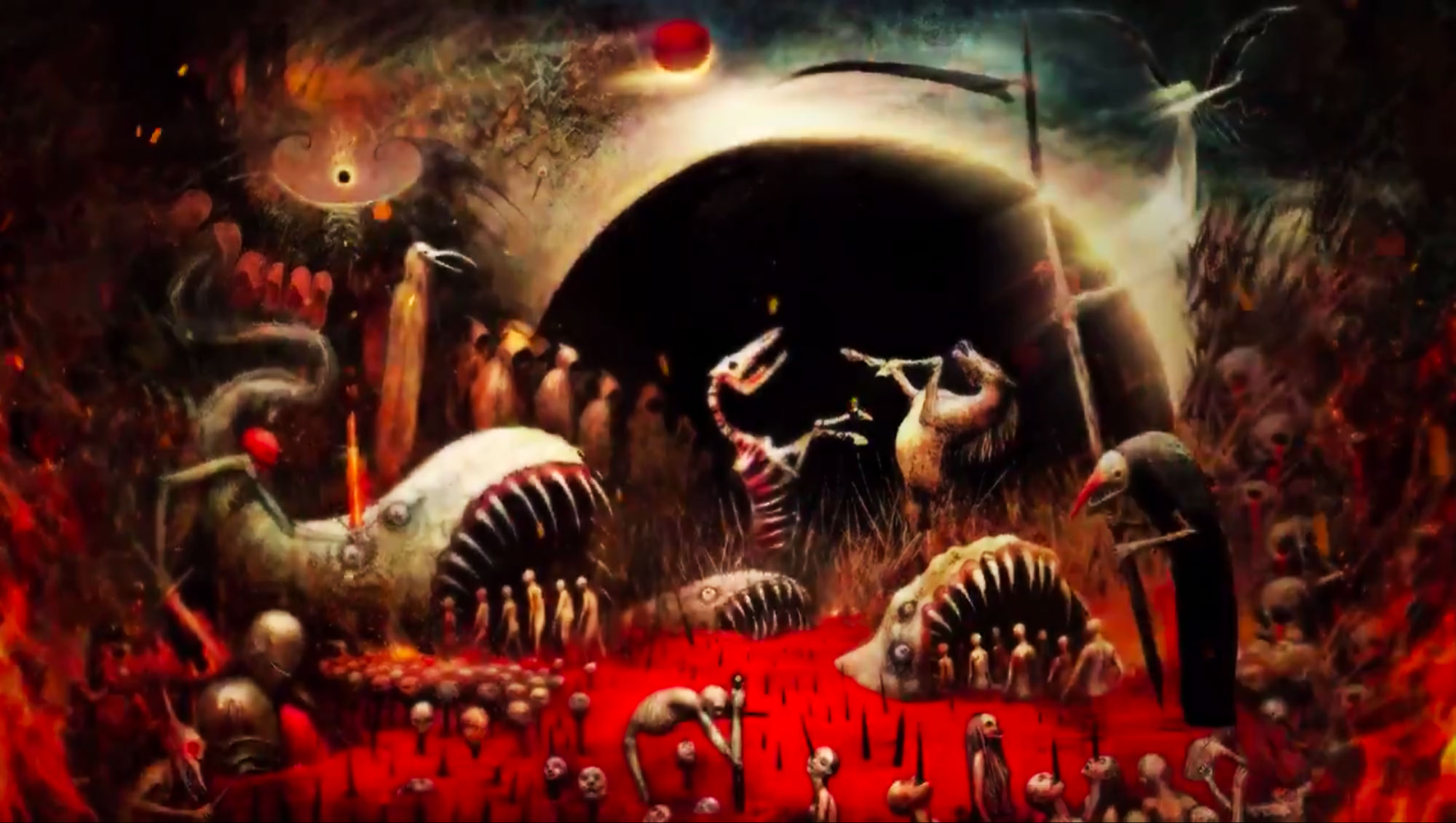
Damnation by Seb McKinnon
The reference point for McKinnon’s Damnation is, of course, Hieronymous Bosch—most obviously The Garden of Earthly Delights triptych the Dutch painter produced sometime around 1500. The stormy blacks of the hellish sky, the bone-and-ochre tones of the foregrounded figures—it’s a pretty blatant allusion, even if McKinnon hadn’t pointed it out specifically on his Twitter. It’s a Magic spin on Bosch, though, with a Soulherder-esque demon presiding over the scene and hordes straight out of Bedevil in the margins. Bosch’s hellscapes are fantastic in the most literal sense—I used to pore over Delights and Bosch disciple Pieter Bruegel’s The Fall of the Rebel Angels as a morbid kid the same way I pored over my Tempest cards. So I’m upgrading my Damnations immediately, starting with the wear-gnawed Player Rewards foil in my Kagemaro deck and the sideboard-two-ofs in my Modern control deck.
McKinnon is an incredible fit for Magic because he’s a narrative artist. He’s worked on films, and that experience shows in the way he fills in the gaps. One of my favorite cards—on every level—from the last year is Feast of Succession from Commander Legends. While the flavor is on-point, it’s McKinnon’s art that makes it ring out. We can clearly see the story here, the Pyrrhic victory of a feast that turned into an abattoir, leaving a power vacuum and a pile of bodies. There’s a whimsy to it, and an elevated horror, as well, and it’s anchored by art that’s midway between a narrative tapestry and an illustrated manuscript. I can’t praise it highly enough, other than to say that I’ve forced it into every deck that can cast it—and that, in Magic, is the highest praise any player can offer an artist.
A lifelong resident of the Carolinas and a graduate of the University of North Carolina, Rob has played Magic since he picked a Darkling Stalker up off the soccer field at summer camp. He works for nonprofits as an educational strategies developer and, in his off-hours, enjoys writing fiction, playing games, and exploring new beers.

